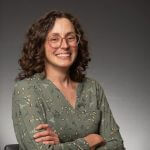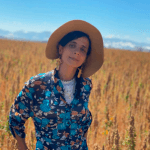Ann-Marie Mitroff
Santa Cruz, CA
Ann-Marie was honored as a River Hero at River Rally 2022.
Transcript
How did you begin working in the water and coalition-building space?
Some people go to school knowing exactly what they want to do. I was not that person. My parents were in the hotel business in Vermont and my first job was a dishwasher at 10, then a maid, then a waitress at 16. My love of rivers sprang from the Black River in Springfield, Vermont and the Neshobe River in Brandon. When I was 8, I flew across the country with my aunt and uncle in a 4-seater plane. I sincerely think that my entire framework for how I viewed the world and saw the landscape changed on that flight.
I went to college in Oregon in 1968. I had a work study job with a woman who matched kids with volunteer assignments. This experience totally framed how I worked on river projects later on because I learned that you don’t try to fit everybody into the same shoe. If you don’t meet people where they are, then you’re going to lose them as volunteers. You can’t force people into a role that doesn’t work for them. These kinds of things really made a huge difference to me in my career.
What was your first experience working with volunteers?
One of my first jobs out of college was with a political campaign, which led to the Energy Extension Service. I developed the equivalent of a master gardener program where we trained people and they gave us some number of hours back. It was a pilot program funded by the Federal Government. I designed an 8-week class for volunteers. We had people come out every Saturday, from 9-3, and they did conservation work around town.
Then my husband, Norman, got a job with the National Bureau of Standards. We moved to DC and I worked for the carbon dioxide research division of the Department of Energy on climate change. Our consulting firm was editing the first climate journals to be published by the government. There were four: two on CO2, one on vegetation effects, and one on sea level rise. That was in 1983. It was an extraordinary two to three years of work.
What did your experience growing up in a hotel teach you about managing a team or coalition?
I learned that you have to take the strength of the people you have. Your chefs, waiters, front desk clerks all might have family. You work around that stuff. They might be sick or they have to take care of their mother, but things had to get done. It was 365 days a year, three meals a day. I learned that everybody was in the same boat. I felt like I couldn’t just be the privileged daughter, I had to work as hard as they did.
How did the Urban Waters Learning Network come about?
River Network and Groundwork USA decided to apply for this EPA grant together. It was so easy to do with Diana Toledo (River Network’s Senior Director of River Programs) and, between the two organizations, we figured out a budget and the vision came together quite clearly. We decided that we ought to have a way to share what our partners were doing together, so we arranged for them to get together at River Rally to meet face-to-face. What started as this little idea turned into something much bigger. The next year, the EPA coordinators wanted to take the grants back, but they loved this Learning Network. And look what happened with it! What started as this little idea of getting people together really became our work. This idea really fit beautifully into what Diana does and what she is about; and also worked with Groundwork USA, which had groundwork trusts surrounding it. We had all these loosely-combined organizations that were benefiting from the Learning Network. It was so down Diana’s and my alley.
The Learning Network was so much like when I was working in water conservation in California during a 7-year drought (1986-1993) because there were quarterly meetings of all the coordinators throughout California, and I attended those meetings. They became mini-conferences, and it was essentially a learning network! So, I pulled a lot from that experience. For example, the two-minute drill, which we had done at River Rally in the past, asks about the biggest thing that happened in the last year that you want to brag about; or the thing that you didn’t do well, and you failed and flailed at. They’ve always been one of the most important parts of those meetings. The concept of an open space for discussion has driven a lot of my work. I’m not the person who has all these great ideas. Even in my Saw Mill River experience, I learned that you have to listen to people. People have so many great ideas. If you’re the person stuck doing everything you’re going to become exhausted, you won’t go home, and people won’t listen to you! But what you get with great partners is incredible ideas and improvements to your programs. You’ll find that the product just works for more people. And I’ve had so much damn fun doing it.
Thinking back on your time with Groundwork USA and the Urban Waters Learning Network, what was one of your most impactful experiences?
In the Groundwork Green Team program, what always struck me was our graduates and tracking the first kids who graduated from the program. It pains me that there is so much talent that we are not unleashing. I’ve been really privileged in my life with internships and other opportunities that launched my career. It’s easy for an organization to get free interns from the higher income communities, but we don’t tend to design programs for those who can’t work without a salary. A group of Learning Network folks have led some sessions at Rally and I think they made a difference to the people who came to River Rally in terms of getting these programs off the ground. I’m seeing more of those programs and it’s really heartening to see.
What advice would you give to other conveners out there who are struggling to get their communities or groups together?
I give people the hardest time. One of the things I learned is persistence. I remember trying to get a meeting with one woman years ago. I had been calling for two or three months. She said, “Your gentle persistence is good, don’t let up.” It has really helped. Another thing: we’ve all scheduled meetings hoping for a great crowd. Sometimes you have great idea about who is going to come and 10 people show up. But those 10 people showed up. It took me a long time not to worry about who is going to show up. Usually, they have more time and they may surprise you. And I’ll tell you something my mother said. It doesn’t matter what you do, as long as you call it a picnic. You could doing really hard work, but it’s all about attitude.
What are your hopes for the future of the programs that you have worked on and the people who are continuing this work?
Some of my hopes have already happened. I love the person they hired for my position in the Hudson Valley. It really shows you what can be accomplished when you fully fund and support a position. The work on the Saw Mill River is ongoing and they’ve brought in even more community members who have become advocates for the river.
What we have to understand about volunteer work is that, unless there is a coordinator in a paid position, the strength of a volunteer network is hard to unleash over a whole watershed. But you see the difference where there is even a part-time coordinator to make it happen. I’ve always thought that this is what we should be doing with EPA or state funding. Look at the rivers that don’t have any help and fund a position.
Rivers are amazing and people come to them for different reasons. And sometimes people don’t know they love it until they get there! You have people out there doing yoga and meditations, or creating art. We had the Roller Derby girls come out to an event on the Saw Mill once. Don’t just do projects. Cleanups and tree-plantings are an absolute gas, but they’re not necessarily what will inspire everyone to come out.
What is next for you?
There is some conversation in the Urban Waters Learning Network happening around homelessness. The Coastal Watershed Council here in Santa Cruz is doing work in that area and I am debating whether or not I have the energy to dive into the issue. Statistically, Santa Cruz has the highest per capita homeless population in the country. It’s a hugely important issue that affects people and the river; and it’s also challenging because it is a multi-dimensional problem that rarely has one solution.
About
As coordinator of the Saw Mill River Coalition, Ann-Marie guided the habitat plan and community involvement for Yonkers’ $18 million river daylighting. She co-founded the Urban Waters Learning Network (UWLN), an EPA-funded partnership between Groundwork USA and River Network. The UWLN, now with over 500 member organizations, has carved out a dynamic niche within the environmental and social justice movements, leading the way in conversations about equitable development, access, and environmental justice.







